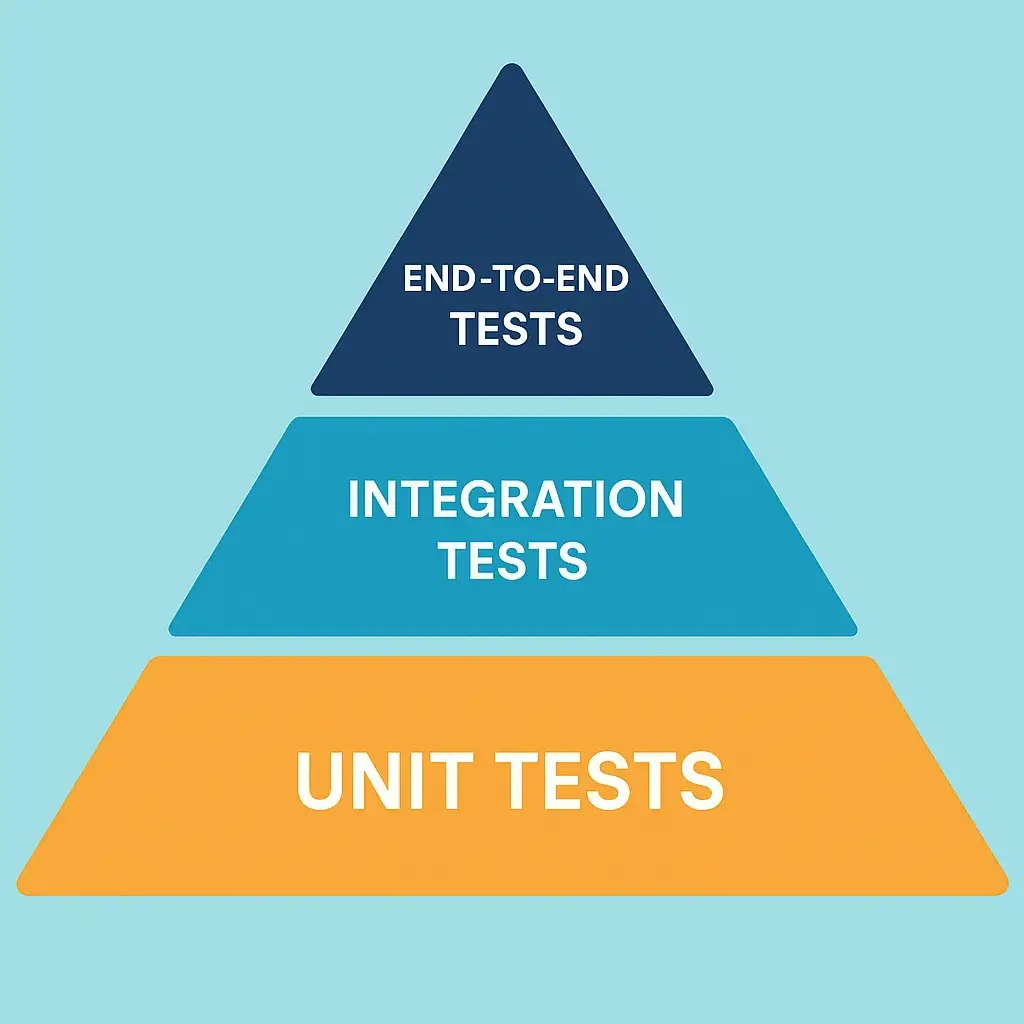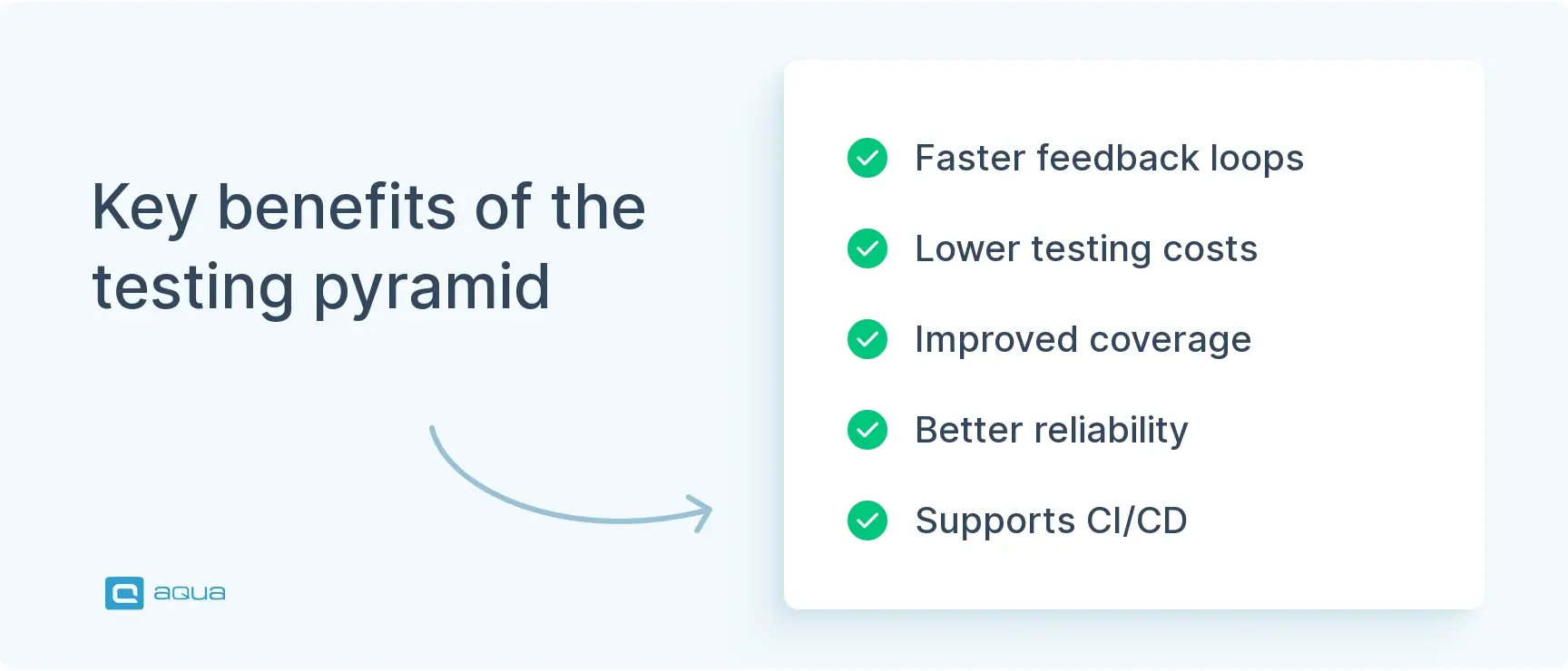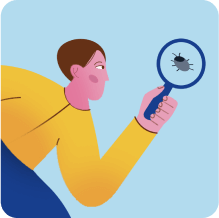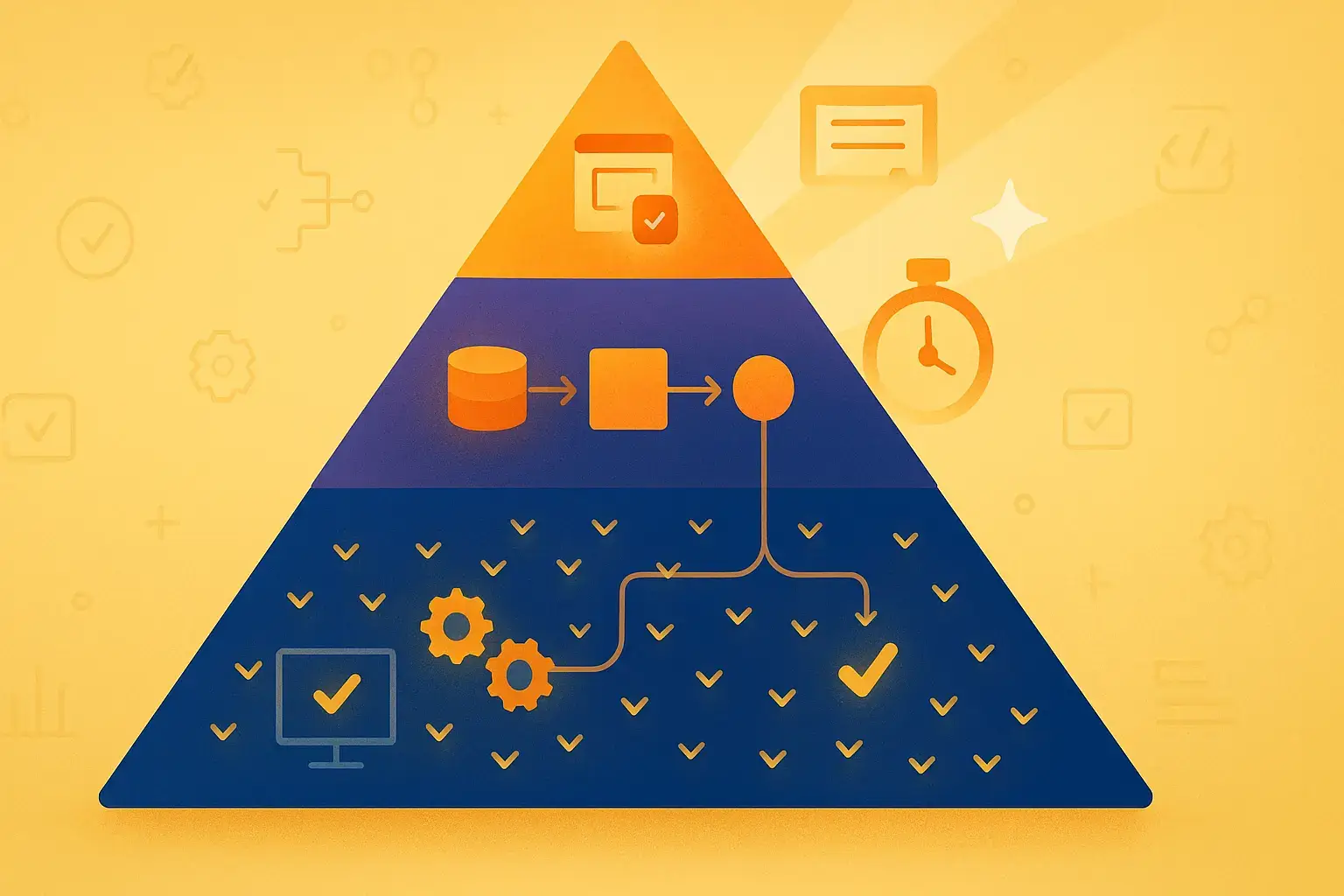What is the Testing Pyramid?
Mike Cohn introduced the testing pyramid in “Succeeding with Agile.” It’s a simple visual model that shows how to distribute your testing efforts across three levels. Picture a pyramid. Wide base of unit tests at the bottom. Smaller middle layer of integration tests. Even smaller top section of end-to-end tests. The shape is strategic, no matter how random it sounds. Most of your testing effort should happen at the bottom.

Think about it this way. A unit test runs in milliseconds and fails only when the code breaks. An end-to-end test takes minutes to run and might fail because your test environment is slow. Which one do you want running every time you save a file? Here’s what each level tackles:
- Unit tests (base): Individual functions or methods in isolation
- Integration tests (middle): How components work together
- End-to-end tests (top): The full user journey through your application
The higher you climb the pyramid, the slower and more brittle your tests become. Unit tests catch logic errors in seconds. Integration tests catch interface problems in minutes. End-to-end tests catch user experience issues, hopefully before your users do.
Levels of the Testing Pyramid
Now that you understand the basic structure, let’s dive into what each level actually does in practice. Each layer serves a different purpose and catches different types of problems. Understanding when and how to use each one will determine whether your testing strategy helps or hurts your development speed.
Unit Tests (Base of the Pyramid)
Unit tests verify that individual functions do exactly what they’re supposed to do. Nothing more, nothing less. Think of testing a calculateDiscount() function with different inputs to make sure it returns the right percentage every time. These tests run thousands at a time in seconds. They give developers immediate feedback when something breaks. No waiting around for slow test suites or dealing with flaky network calls. A good unit test is isolated. No database calls. No API requests. No file system access. Just pure logic testing. The same input always produces the same output. If your test sometimes passes and sometimes fails with identical code, it’s not a unit test. It’s a headache.
Popular unit testing tools include:
- JavaScript: Jest, Mocha, Jasmine
- Python: pytest, unittest
- Java: JUnit, TestNG
- C#: NUnit, MSTest. Here’s the magic: unit tests catch regressions instantly. You write a function, test it works, then six months later, someone modifies it for a new feature. If they break the original behaviour, the test fails immediately. No debugging sessions. No “it worked on my machine” conversations. Most of your testing effort should happen here. Aim for this level to carry the heavy lifting.
Integration Tests (Middle Layer)
Integration tests verify that your components actually work together. Your user service talks to the database correctly. Your payment processor connects to your order system without errors. These tests cross the boundaries that unit tests can’t touch. Unlike unit tests, integration tests hit real systems. They call actual databases. They make HTTP requests to real services. They interact with the file system. This makes them slower and sometimes unreliable, but they catch problems that unit tests miss. Think about interface mismatches. Your user service expects a “userId” field, but the database returns “user_id”. Unit tests won’t catch this as they mock everything. Integration tests will fail immediately when they try to connect the real components.
Common integration testing tools include:
- API Testing: Postman, REST Assured, Supertest
- Database: DBUnit, TestContainers
- Message Queues: JMSUnit, EmbeddedAMQ
Focus integration tests on critical system boundaries. Test your authentication flow from login request to token generation to database storage. Don’t try to test every possible user path. That’s what E2E tests are for.
End-to-End Tests (Top of the Pyramid)
End-to-end tests simulate real users clicking through your application. They fill out forms. They navigate between pages. They complete entire workflows from start to finish. These tests verify that everything works together to deliver the actual user experience. E2E tests are expensive but necessary. They catch problems that slip through other test layers. Can a customer complete checkout? Can they reset their password? Can they upload a file and see it appear in their dashboard? These are the questions E2E tests answer. The tradeoffs are significant. E2E tests run in minutes instead of seconds. They fail randomly due to timing issues, network problems, or browser quirks. UI changes break them constantly. That’s why you need fewer of them.
Popular E2E testing tools include:
- Web: Cypress, Selenium, Playwright
- Mobile: Appium, Detox, Espresso
- API: Postman, Karate
Be selective with E2E tests. Don’t test every feature; test critical business paths. User login. Purchase completion. Account management. Data export. Pick the workflows that absolutely must work for your business to survive.
Is your team struggling to implement an effective testing strategy that balances speed and quality? The testing pyramid offers a clear structure, but managing different test types across your agile workflow requires the right toolset. This is where aqua cloud shines as your comprehensive test management solution.
With aqua cloud, you can seamlessly organize and track tests across all pyramid levels, from unit tests at the base to end-to-end tests at the top. Its AI-powered test case generation capabilities help you quickly create tests aligned with testing pyramid principles, saving up to 98% of your team’s time. The platform’s real-time coverage tracking instantly reveals gaps in your testing strategy, ensuring you maintain the ideal balance of test types while achieving 100% requirement coverage.For agile teams continuously shipping code, aqua’s integration with tools like Jira, Confluence and Azure DevOps keeps everyone synchronized, with complete traceability between requirements, test cases, and defects. No more guessing which requirements remain untested or where your quality risks lie.
Implement a balanced, efficient testing pyramid and deliver higher quality software faster
Benefits of the Testing Pyramid
The testing pyramid has several benefits that do not stay on the paper, it delivers measurable improvements to your development process. Here’s what changes when you get the balance right. These benefits compound over time, making your team faster and your software more reliable.
Faster Feedback Loops
Unit tests give developers feedback in seconds. Write a function, run the test, see if it works. No waiting for builds. No deployment pipelines. No manual testing cycles. This speed changes how developers work. They catch bugs immediately instead of hours later during integration testing. Problems get fixed while the code is still fresh in their mind. Context switching becomes minimal. According to a study by Microsoft, teams that implement the testing pyramid reduce their overall debugging time by up to 60%.
Lower Testing Costs
Creating an end-to-end test takes 4-8 hours. Creating a unit test takes 10-30 minutes. The math is simple, you get more coverage per hour invested when you focus on the pyramid’s base. Maintenance costs follow the same pattern. Unit tests break only when logic changes. E2E tests break when someone updates a CSS class, changes a button label, or modifies the deployment environment. Consider this comparison:
| Test Type | Creation Time | Run Time | Maintenance Cost |
|---|---|---|---|
| Unit Test | 10–30 min | < 1 sec | Low |
| Integration Test | 1–2 hours | 5–30 sec | Medium |
| E2E Test | 4–8 hours | 1–5 min | High |
Improved Test Coverage
The pyramid approach makes it feasible to test more of your application. A project might have thousands of unit tests but only dozens of E2E tests, yet achieve better overall coverage.
Better Test Reliability
Unit tests are deterministic. Same input, same output, every time. E2E tests fail for dozens of reasons that have nothing to do with your code: network timeouts, browser updates, third-party service downtime, and race conditions. When your test suite is mostly unit tests, failures actually mean something. Developers trust the results. Red builds get attention instead of being ignored as “probably flaky.”
Supports Continuous Integration
Unit tests run in seconds, so they can run on every commit. Integration tests run in minutes, so they can run on every merge. E2E tests run in hours, so they run nightly or before releases. This creates a fast feedback pipeline. Developers know immediately if they broke something. The team knows quickly if integration problems exist. Critical user paths get validated before customers see them.

How to Implement the Testing Pyramid in Your Workflow
Let’s get practical now.
Most teams don’t start with a perfect pyramid. You probably have scattered tests, heavy reliance on manual QA, or an inverted pyramid with too many slow E2E tests. Here’s how to fix it without rewriting everything from scratch.
1. Assess Your Current Testing Mix
Count your tests. How many unit tests do you have? How many integration tests? How many E2E tests? Most teams discover they’re top-heavy—dozens of brittle UI tests and barely any unit tests. Look at your test run times too. If your “quick” test suite takes 20 minutes, you’ve got pyramid problems.
2. Start With Unit Testing
Begin with the foundation. Pick a core module of your application and boost its unit test coverage. Focus on:
- Business logic with complex rules
- Code that changes frequently
- Areas with past bugs
Resist the urge to test simple getters and setters. Test the logic that actually matters.
3. Set Concrete Goals
Don’t aim for perfect ratios immediately. If you currently have 10% unit tests, aim for 40% first. Then 60%. Then 70%.
Set time-based goals too. “New features must include unit tests.” “Bug fixes need regression tests.” “Refactoring requires test coverage first.” This gives everyone a clear direction without being overly prescriptive.
4. Add Integration Tests Strategically
Once you have solid unit test coverage, identify key integration points in your system:
- API contracts between services
- Database interactions
- Third-party service connections
Write focused integration tests for these boundaries.
5. Reserve E2E Tests for Critical Paths
Identify the must-work user journeys in your application. These are your candidates for E2E tests:
- Login and authentication
- Core business transactions
- Payment processing
- Data-critical operations
6. Integrate With Your CI/CD Pipeline
Structure your pipeline to run tests in parallel (according to CI/CD pipeline), with the fastest tests first:
- Unit tests run on every commit
- Integration tests run on successful unit tests
- E2E tests run before deployment or nightly
7. Monitor and Improve Test Quality
Monitor these metrics:
- Test distribution: Are you moving toward the pyramid shape?
- Failure rates: Which test types catch real bugs vs false positives?
- Run times: Are your fast tests staying fast?
- Developer adoption: Are people actually writing tests?
Adjust based on what you learn. If integration tests keep failing due to environment issues, simplify them. If unit tests aren’t catching bugs, improve test quality.
Challenges and Considerations
Almost every team hits roadblocks when shifting to pyramid testing. Good news is, these problems are predictable and solvable. Here’s what to expect and how to deal with each challenge:
Legacy Codebase Challenges
Old code wasn’t written for testing. Functions have hidden dependencies. Classes are tightly coupled. Methods do too many things at once. Don’t try to test everything immediately. Follow these instead:
- Use integration tests as a safety net while refactoring
- Implement the “Strangler Fig” and gradually replace untestable legacy code by building new, testable components around it. Redirect functionality step by step until the old code can be safely removed.
- Add tests for new code while progressively improving test coverage for old code
Focus on the code that changes most often. That’s where tests provide the biggest return on investment.
I see it as a grid where one axis is control and one is scope. The more scope you test, less control. This is integration testing. You cannot decide a database call will fail randomly from the api layer. More scope (api, logic, database) with less control (cannot mock db response). This is fundamentally why unit testing is considered foundational. More control for less scope. What if the database is locked up? How will we respond? Well, just test the unit and mock the database and lets find out.
Flaky Tests
Nothing kills test confidence faster than random failures. E2E tests are the worst offenders, but integration tests can be flaky too.
Fix flaky tests immediately:
- Implement retry mechanisms for non-deterministic tests
- Quarantine flaky tests until fixed
- Use explicit waits instead of implicit/fixed timeouts
- Minimise dependencies on external services in test environments
Overemphasis on Coverage Metrics
Teams see “80% coverage” as a goal and start writing useless tests. They test getters and setters. They mock everything to hit coverage targets. They ignore critical business logic that’s hard to test. Coverage tells you what’s not tested, not what’s well tested:
- Focus on testing business-critical paths rather than arbitrary coverage targets
- Combine coverage metrics with other quality indicators
- Emphasise requirement coverage over code coverage
Maintaining Test Data
Integration and E2E tests often need realistic test data. Creating and maintaining this data becomes a nightmare as tests multiply. Build data programmatically:
- Use factories or builders to create test data programmatically
- Implement database seeding in test environments
- Consider using Docker containers for isolated test environments
- Look into test data management tools for complex scenarios
Clean up after every test. Leftover data from one test shouldn’t affect another.
Skill Gaps
Not everyone knows how to write good tests. Some developers have never written unit tests. Others write tests that are harder to maintain than the code being tested. Invest in skills development:
- Pair programming sessions focused on testing
- Using AI to generate comprehensive unit tests faster
- Regular code review with testing focus
- Internal workshops and knowledge sharing
- Establishing testing patterns and examples for the team
Conclusion
So what did we learn? The testing pyramid works because it matches how software actually breaks. Most bugs live in business logic that unit tests catch quickly. Some bugs happen at integration points that focused integration tests find efficiently. A few bugs only surface in complete user workflows that E2E tests validate expensively. By putting most of your testing effort at the bottom of the pyramid, you catch more problems faster and cheaper than any other approach. Your goal is shipping better software more confidently. The pyramid gives you a framework to make smart tradeoffs about where to invest your testing time.
Now that you understand the power of the testing pyramid approach, how will you implement it effectively across your workflows, according to agile trends? Most teams struggle with maintaining the right balance of unit, integration, and end-to-end tests, especially when tests are scattered across different tools and repositories.
aqua cloud provides a unified platform for managing your entire test ecosystem. Its powerful requirement traceability features ensure complete visibility into test coverage across all pyramid levels, instantly highlighting areas where you need more unit tests or where expensive end-to-end tests could be replaced with faster alternatives. With aqua’s AI Copilot, your team can automatically generate comprehensive test cases using proper techniques like Boundary Value Analysis and Equivalence Partitioning, ensuring methodical coverage without the manual effort. The platform’s deep integration capabilities connect seamlessly with your existing tools like Jira, Confluence, and Azure DevOps, making the testing pyramid accessible to everyone in your organization, from developers to QA specialists to product owners. Custom dashboards and automated reporting provide instant visibility into your test distribution, helping teams maintain the ideal pyramid shape.
Reduce testing time by 80% while achieving 100% test coverage with aqua's balanced testing approach


















